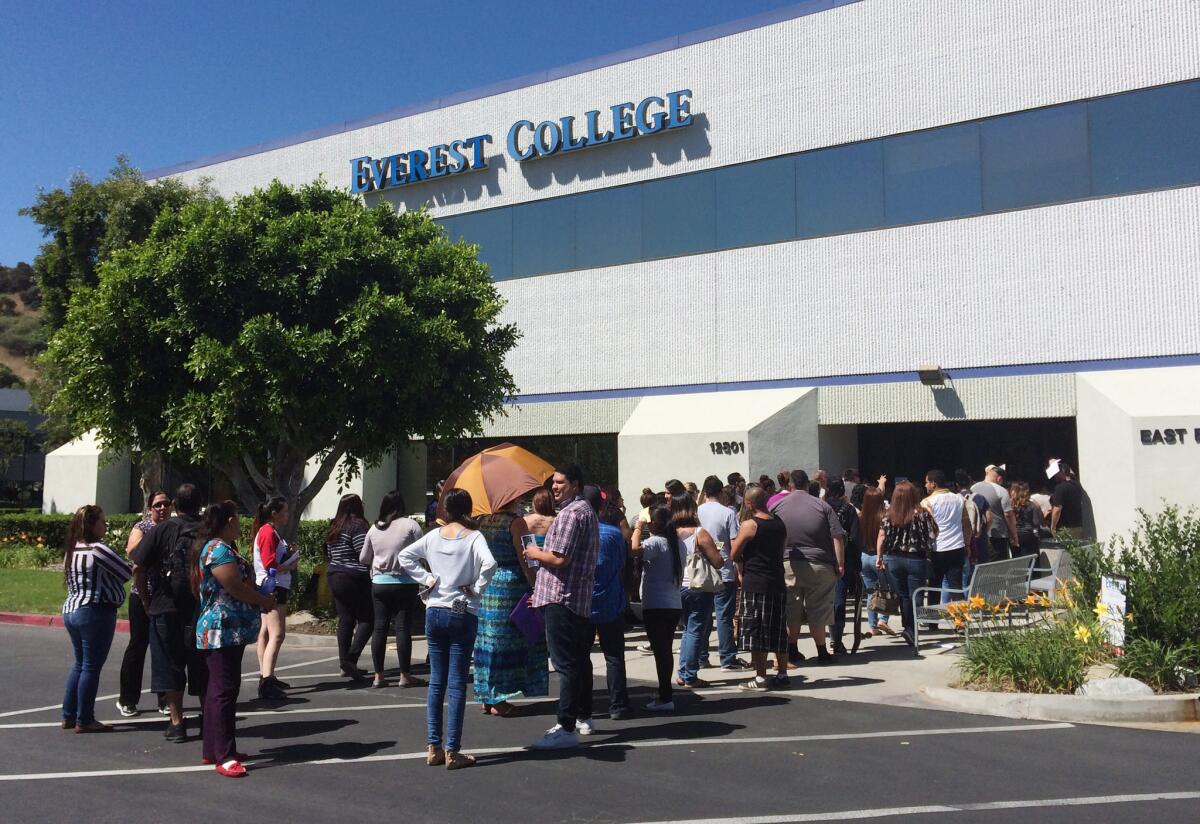Op-Ed: Corinthian Colleges: The high cost of regulatory neglect

- Share via
For years, private for-profit colleges were Wall Street darlings. Robust margins and a business model that does best when the economy does worst enabled these companies to add hundreds of thousands of students, all funded by billions of dollars in federal subsidies.
What skyrocketed upward is now coming down, and the landing is not pretty. Corinthian Colleges, which a year ago had more than 72,000 students under the Everest, Heald and WyoTech brands, slowly collapsed over the last 10 months before announcing Sunday that it would close its final 28 campuses. The move leaves 16,000 students scrambling to sort out their educational futures.
Corinthian could have made this turbulent end smoother if it had exercised any real care for its students. Closure was inevitable since last June when the Department of Education delayed payments of federal student aid dollars due to concerns that Corinthian was not truthful about its students’ ability to find employment. At that point, Corinthian agreed to sell most of its campuses, and ultimately it unloaded 56 campuses in a deal assisted by the Department of Education that was finalized in February. But rather than wind down operations, Corinthian stayed defiant. Through April 17, it continued to enroll new undergraduates.
For some, at least, there is a silver lining — current students or recent dropouts who do not transfer credits to another college will have the opportunity to discharge their federal debts. Students who want to transfer will hopefully find cheaper and better educational options. But sorting through possibilities will require guidance from the Department of Education.
Corinthian may be the first for-profit higher education company to fall, but there is no guarantee it will be the last. Many of the more than one dozen publicly traded higher education companies are shedding students and campuses. Education Management Corp., which runs Brown Mackie and several other colleges, said in August that it was undergoing a major debt restructuring. Just last week, DeVry announced it was closing 14 campuses. Even the University of Phoenix, the nation’s largest for-profit college, has not been immune. That school has lost several hundred thousand students over the last few years and is roughly half its former size.
None of these colleges should have been allowed to get so big in the first place. During the Bush administration, the Department of Education, state governments and accreditation agencies stood by while these companies leveraged the power of online learning and Wall Street dollars to grow by leaps and bounds. No one stopped to ask whether they could really handle thousands more students a year and still serve them well.
The Obama administration has taken many steps to reduce the sector’s size, but these efforts are coming after much of the damage has been done. And now we’re seeing the consequences of unchecked growth. Some borrowers who attended Corinthian are refusing to repay their loans and seeking discharges from the Department of Education, asserting that the programs should never have been offered. Borrowers from other colleges may also come forward.
Unfortunately, the costs will not be paid by the companies that created the mess — because they will quickly run out of money. Corinthian certainly does not have the $214 million it would take just to forgive the loans for students still enrolled at the moment of closure. The federal government should continue its efforts to secure funds from Corinthian and other failing colleges, but it won’t be enough.
In the future, colleges must be on the hook upfront for potential bad outcomes. California provides an example of how to do this. The Bureau for Private Postsecondary Education requires some for-profit colleges to assess students a fee, which supports a fund for reimbursing students if the school closes. That system, however, can do only so much, in part because the fund is capped at $25 million.
In the near term, borrowers with debt from worthless programs will be pitted against taxpayers who unwittingly financed them. Policymakers will be stuck in the middle, choosing between two sets of largely innocent victims. That’s the cost of regulatory neglect.
Ben Miller is the higher education research director at New America Foundation.
Follow the Opinion section on Twitter @latimesopinion and Facebook
More to Read
A cure for the common opinion
Get thought-provoking perspectives with our weekly newsletter.
You may occasionally receive promotional content from the Los Angeles Times.









